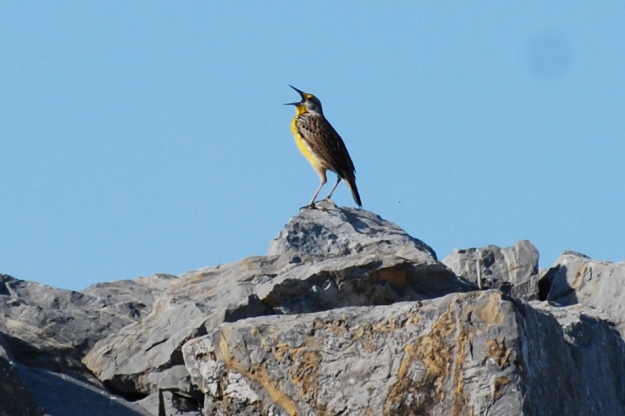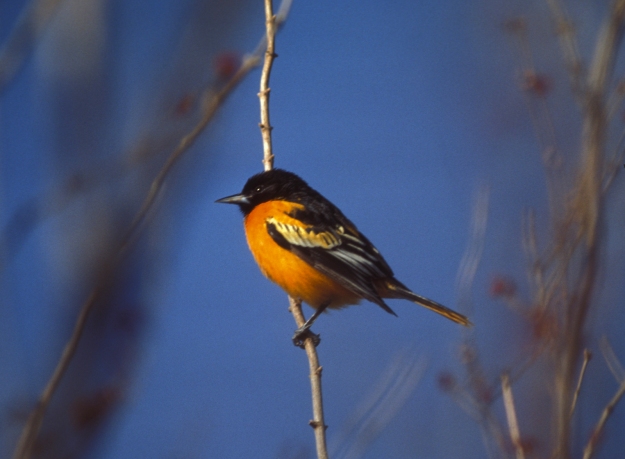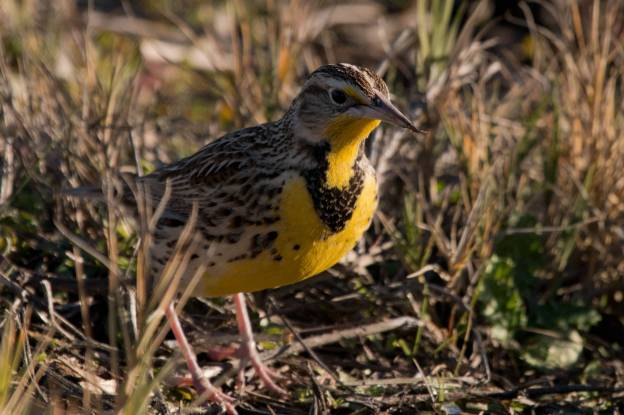 Photo by Jean Potter • A rocky outcrop provides a perch for this singing male Eastern meadowlark.
Photo by Jean Potter • A rocky outcrop provides a perch for this singing male Eastern meadowlark.
It’s always fun to add another notch to one’s list of birds. Whether you’re a casual lister or a devoted birder, a new species always offers a burst of excitement in the wake of a first-time observation.
Sharon Foster sent me an email recently to share her excitement about a sighting.
“I’m excited to say my daughter and I spotted a meadowlark up on Cross Mountain last week,” Sharon wrote in her email.
Sharon said she hadn’t been able to do a lot of bird watching other than in her yard and nearby places.
“I never thought I was going to see a meadowlark,” she noted. They are fantastic. We were thrilled. He was just sitting on the fence.’
She added that she didn’t have her good zoom camera with her, or else she could have taken a picture. She will still have her memory of her first sighting, and that’s what is important.

Photo by USFWS • Baltimore orioles, like this male, are members of the blackbird family, making them relatives of species such as Eastern meadowlarks, brown-headed cowbirds, common grackles and red-winged blackbirds.
She also told me about a Baltimore oriole feeder she bought last fall late in the season.
“I read they usually come around early in spring,” Sharon wrote. She added that she spotted one in her yard by South Holston Lake several years ago.
Of course, when spring rolled around she nearly forgot about the feeder. “It was around mid-April when I thought about it and thought it was too late,” she wrote. “But I put it up anyway and lo and behold the next day there was an oriole in our pine tree.”
It was another memorable birding moment. “Talk about being excited,” Sharon wrote. “Wow! Birds can do that to you!”

Both the Baltimore oriole and the Eastern meadowlark belong to the family of birds known as icterids, or blackbirds, which also includes species like bobolink, brown-headed cowbird, common grackle and red-winged blackbird.
The Eastern meadowlark is a distinctive bird. It has brown plumage accented by black, with bright-yellow underparts and a bold black V across the chest. Though most of the tail is brown with blackish barring, the outer feathers are white and are a conspicuous trait to look for when the bird is in flight.
The Eastern meadowlark is considered a grassland bird and remains common in habitats such as prairies and other native grasslands. The meadowlark has proven adaptable as long as it can occupy unbroken grassland of about six acres or more. Pastures, fields and even airports have proven suitable habitats for meadowlarks. As suburban areas and subdivisions expand into rural areas, meadowlarks can hang on unless the grassland habitat becomes too segmented and broken into sections too small to be of value.

Photo by Peter Pearsall/USFWS • Eastern meadowlarks spend a lot of time on the ground while searching for insects.
Meadowlarks eat mostly insects, especially in summer. For the winter months, these birds will adapt their diet to include seeds, spilled corn and fruit. Meadowlarks, unlike other relatives among the Icterids, or blackbirds, do not typically visit feeders.
These birds construct nests close to the ground. Meadowlarks nesting in fields mown for hay face disaster if the grass is cut before their young have left the nest. The female meadowlark constructs the nest and lays two to seven eggs, which will require an incubation period of about two weeks. Even after hatching, the young are not capable of leaving the nest for another 10 to 12 days. Consequently, young meadowlarks are vulnerable for a month, not only to predators but to a farmer deciding to mow a hayfield.
While the Eastern meadowlark remains common, its numbers have suffered severe declines. such that they are considered to be a declining species. Populations fell more than 3 percent a year between 1966 and 2015, resulting in a cumulative decline of 89 percent, according to the North American Breeding Bird Survey. According to the website All About Birds, early mowing, overgrazing by livestock and pesticide use are all detrimental to meadowlark survival.
The highest population densities for the Eastern meadowlark are found in the Central Mixed Grass Prairie and the Eastern Tallgrass Prairie regions of the central United States. As the name suggests, the Eastern meadowlark has a counterpart in the western half of the United States. This is reflected in the fact that five central and western states — Kansas, Montana, Nebraska, North Dakota, Oregon and Wyoming — have made the Western meadowlark their official state bird. Ironically, the Eastern meadowlark has not been honored with that designation by any of the states it inhabits.
The difference in the two species rests not so much in their appearance as in their songs. The western meadowlark has distinctive vocalizations described as rather flute-like, which distinguish it from the closely related eastern meadowlark. Male Eastern meadowlarks seek out elevated perches to produce a musical, flute-like song in the spring. Utility wires, treetops and fence posts provide some of their favorite perches. Their singing is mostly used to define the borders of their grassland territory.
Finally getting your binoculars on a bird you’ve never seen is always an exciting moment. As we draw closer to the fall season, many different birds will migrate through the region. Fall migration is a great time to spend some time outdoors and try to see some birds that are new. Do some advance homework with a good field guide and study the birds that migrate through the region. Then, simply monitor your yard or a favorite park and wait to see some new species as they make migratory stops in the region.

Early American naturalist and painter John James Audubon painting this scene depicting nesting meadowlarks.

